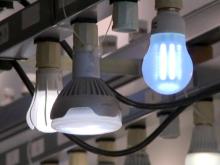Between all of the interesting shapes and sizes and decoding the letter names, deciding which lightbulb to buy is a lot tougher these days.
This constantly cycling lightbulb lab Consumer Reports tests both compact fluorescent and LED bulbs. The bulbs go on and off every two minutes.

Tests show LEDs have some real advantages. Some CFLs burnt out, but all the LEDs are still going strong after 200,000 cycles.
And unlike CFLs, some LEDs can be dimmed as low as an incandescent bulb. Another plus - they come to full brightness instantly.
Consumer Reports also tested lightbulbs' brightness and color temperature, and a computer analyzed the results.
"We found that some LEDs have the same warm glow as incandescents," said Dan DiClerico of Consumer Reports.
But not all LED bulbs are stellar. The Miracle LED was not such a miracle. It claims to be equivalent to a 60-watt incandescent. But it's not as bright as a 40-watt bulb. And while it's long lasting, it gives off a strange bluish-white light.
With all LEDs, the big disadvantage is the price. Many cost $20 or more per bulb.
"LEDs are more expensive," DiClerico said. "But they're designed to last so long - 23 years or more - that you'll likely save about $130 over their lifetime."
So, which LEDs are best? Among 60-watt equivalents, Consumer Reports top-rated two: EcoSmart from Home Depot, which produces a white light; and the 121/2-watt Philips, which has a warmer, yellower light. Both cost around $25.
Consumer Reports says prices of LEDs are coming down and are expected to keep dropping. And unlike CFLs, LED bulbs don't contain any mercury. That means cleanup is easier if a bulb happens to break.





